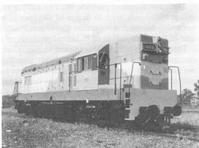


Chapter 7
I The First 100 Years 1788-1888
II Railways
i Location of the Railway
ii Track
iii Bridging and Tunnelling
iv Dams for Engine Water
v Locomotives and Rolling Stock
vi Signalling and Telecommunications
vii 1900/1988-The New Century
viii The Garratt Locomotive
ix Steam Locomotive Practice
x Motor Railcars
xi Signalling
xii Electric Tramways
xiii Electric Railways - Direct Current
xiv Electric Railways - 25 kV ac
xv Diesel Traction
xvi Alignment and Track
xvii Operations
III Motorised Vehicles
IV Aviation
V Modern Shipping
VI Innovative Small Craft
VII Conclusion
VIII Acknowledgements
IX Contributors
References
Index
Search
Help
Contact us

Diesel Traction
Save for the introduction of superheat, and steady enlargement, steam locomotive technology changed little from the late Edwardian to the postwar era. But the world outside the railways changed greatly, and after the First World War labour costs, social expectations and resistance to the coal dust, exhaust and ash nuisances of steam escalated alarmingly. Supply of the traditional fuel -coal -was also subject to increasing disruption from labour unrest. The steam engineers reacted by increasing application of wear reduction and labour saving devices to cut the cost of preparation, disposal and maintenance and by introducing oil firing. But they were fighting a losing battle.The main-line diesel-electric (Fig. 11) was the answer, and the first diesels were introduced in the early 1950s, applying imported British and particularly U.S. technology and power equipment to Australian designs and mechanical specifications. Australian manufacture of traction motors and auxiliaries increasingly followed.[11]

No other single development revolutionised the main-line railways so beneficially, so quickly and so universally as the diesel electric locomotive. While there were major economies from low cost distillate fuel, the diesel locomotive went much further than that. It worked longer, ran further and demanded much less attention than the two to three steam locomotives it displaced. It cost less per ton-km of traffic task and permitted substantial economies through smaller depots, workshops and labour forces, and the elimination of vast but little known watering and boiler repair infrastructures. The diesel engine had a finite power and the locomotive could not be worked at above rated output at all, or at slow speeds and maximum output for as long as a steam locomotive could (by operation at full throttle and long cut offs). But the diesel's superior starting performance (it being an all adhesive locomotive), its superior flexibility for freight and passenger duties, and its ability to operate in multiple unit under a single crew to match power with traffic demand, produced further economies from flexibility of operation. As a result, the complete 'railway towns' that had grown with and around the steam locomotive simply withered away.
In the workshops and locomotive factories the traditional 'in house' equipment (and many of the skills) of foundry, heavy machine shop and boiler shop were replaced by those of the carriage and wagon builder and his sub-contractors.
The Australian diesel-electric locomotives (Fig. 12) used American (Clyde-GM, Goodwin and later Comeng-AIco; GE in association with Goninan) and British power equipment (English Electric was the only widely used marque.) The mainline units had V12 and V16 diesel engines in power ranges from typically 750 to 1350 kW, all but the GM being 4 cycle engines; dc generators (with series-parallel control and automatic transition from the outset); and a variety of electro-magnetic contactor-type switchgear substantially derived from straight-electric practice. Power control principles followed Lemp's 1914 patent. From the earliest days, most diesels also had rheostatic electric (dynamic) brakes which effected major economies in train brake-block wear (especially when descending the Great Dividing Range in the Eastern States.) The near-universal Australian configuration was a 6-axle (Co-Co) unit on 18-22 t axles (1435 and 1600 mm gauges) and 15 t axles on the 1067 mm, lower on branch lines units in both cases (Fig. 12).

Organisations in Australian Science at Work - Australian National Railways; COMENG; Queensland Railways
People in Bright Sparcs - Macfarlane, Ian B.
 |
Australian Academy of Technological Sciences and Engineering |  |
© 1988 Print Edition pages 479 - 480, Online Edition 2000
Published by Australian Science and Technology Heritage Centre, using the Web Academic Resource Publisher
http://www.austehc.unimelb.edu.au/tia/473.html